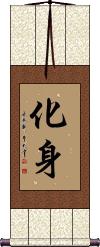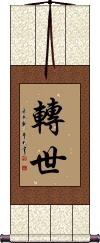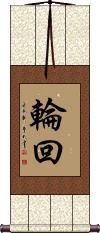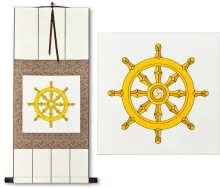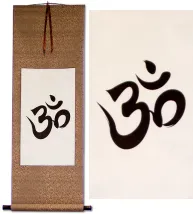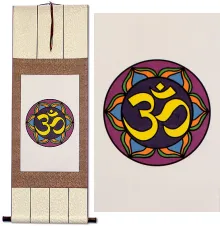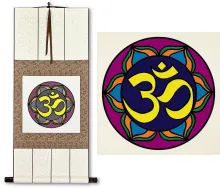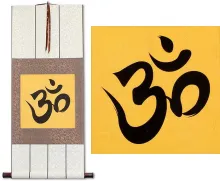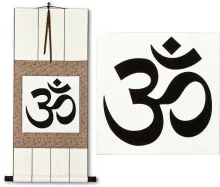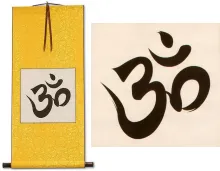Many custom options...
And formats...

The name Reincarnation Buddhism in Chinese / Japanese...
Buy a Reincarnation Buddhism calligraphy wall scroll here!
Personalize your custom “Reincarnation Buddhism” project by clicking the button next to your favorite “Reincarnation Buddhism” title below...
Avatar
化身 is a way to say avatar in Chinese characters, Korean Hanja, and Japanese Kanji.
This is the original Buddhist idea of an avatar (not the movie). This can also mean: incarnation; reincarnation; embodiment; personification; impersonation.
化身 is the Chinese word used for the original Sanskrit, nirmāṇakāya. Alternates for nirmāṇakāya include 應身, 應化身, or 變化身. In the context of Buddhism, this is a Buddha's metamorphosic body, which has the power to assume any shape to propagate the Truth. This title, 化身, is used for the appearance of a Buddha's many forms.
Reincarnation (Buddhism)
轉世 is the Buddhist idea of reincarnation or transmigration.
Other definitions of this term: “Attainer of Nirvana from within the desire realm,” “A practitioner who enters directly into Nirvana from the desire realm, without traversing the form and formless realms. One of the 27 kinds of Hinayana sages,” or simply, “to return again to this life.”
轉世 is also a Japanese title, but the first Kanji was slightly simplified after WWII. Just let us know if you want the modern Japanese version when you order.
Reincarnation / Transmigration of Souls
輪回 is a universal word in Japanese and Chinese that expresses the Buddhist idea of “reincarnation,” “transmigration of souls,” or “the eternal cycle of birth and death.”
In some contexts, this can also mean “karma,” and others will say it represents “samsara.”
The first character means wheel, ring, turn, circle, loop, or rotate.
The second character can be thought of as a suffix meaning “-times.” This second character can also refer to something that revolves, returns, goes back, or is a counter of the number of occurrences of some event.
Together the sum supersedes the parts, and it means reincarnation. But knowing the essence of each character may help you understand some of the meaning behind the word.
![]() Shown to the right is the more common way to write the second character in Japanese.
it’s
an alternate form of this character in Chinese (so neither way is technically wrong in either language). If you select a Japanese calligrapher, expect that is will look like the Kanji to the right.
Shown to the right is the more common way to write the second character in Japanese.
it’s
an alternate form of this character in Chinese (so neither way is technically wrong in either language). If you select a Japanese calligrapher, expect that is will look like the Kanji to the right.
This in-stock artwork might be what you are looking for, and ships right away...
Gallery Price: $72.00
Your Price: $39.88
Not the results for reincarnation buddhism that you were looking for?
Below are some entries from our dictionary that may match your reincarnation buddhism search...
| Characters If shown, 2nd row is Simp. Chinese |
Pronunciation Romanization |
Simple Dictionary Definition |
人道 see styles |
rén dào ren2 dao4 jen tao jindou(p); nindou / jindo(p); nindo じんどう(P); にんどう |
More info & calligraphy: The Tao or Dao of Being Human / Humanity(1) humanity; (2) sidewalk; footpath; (3) (にんどう only) {Buddh} (See 六道) human realm rebirth as a human being |
轉世 转世 see styles |
zhuǎn shì zhuan3 shi4 chuan shih tense |
More info & calligraphy: Reincarnation (Buddhism)To return to this life. |
我 see styles |
wǒ wo3 wo ga が |
I; me; my (1) {Buddh} obstinacy; (2) atman; the self; the ego I, my, mine; the ego, the master of the body, compared to the ruler of a country. Composed of the five skandhas and hence not a permanent entity. It is used for ātman, the self, personality. Buddhism takes as a fundamental dogma 無我, i.e. no 常我, no permanent ego, only recognizing a temporal or functional ego. The erroneous idea of a permanent self continued in reincarnation is the source of all illusion. But the Nirvana Sutra definitely asserts a permanent ego in the transcendental world, above the range of reincarnation; and the trend of Mahāyāna supports such permanence; v. 常我樂淨. |
彼岸 see styles |
bǐ àn bi3 an4 pi an higan ひがん |
the other shore; (Buddhism) paramita (1) equinoctial week (when Buddhist services are held); (2) (abbreviation) (See 彼岸会) Buddhist services during the equinoctial week; (3) {Buddh} (See 此岸) nirvana; (4) (form) opposite bank; opposite shore; shore on the other side 波羅 parā, yonder shore i. e. nirvāṇa. The saṃsāra life of reincarnation is 此岸 this shore; the stream of karma is 中流 the stream between the one shore and the other. Metaphor for an end to any affair. pāramitā (an incorrect etymology, no doubt old) is the way to reach the other shore.; The other shore; nirvāṇa. |
涅槃 see styles |
niè pán nie4 pan2 nieh p`an nieh pan nehan ねはん |
nirvana (Buddhism) (1) {Buddh} nirvana; supreme enlightenment; (2) {Buddh} death; death of Buddha nirvāṇa, 'blown out, gone out, put out, extinguished'; 'liberated-from existence'; 'dead, deceased, defunct.' 'Liberation, eternal bliss'; '(with Buddhists and Jainas) absolute extinction or annihilation, complete extinction of individual existence.' M.W. Other forms are 涅槃那; 泥日; 泥洹; 泥畔 Originally translated 滅 to extinguish, extinction, put out (as a lamp or fire), it was also described as 解脫 release, 寂滅 tranquil extinction; 無爲 inaction, without effort, passiveness; 不生 no (re)birth; 安樂 calm joy; 滅度transmigration to 'extinction'. The meaning given to 'extinction' varies, e.g. individual extinction; cessation of rebirth; annihilation of passion; extinction of all misery and entry into bliss. While the meaning of individual extinction is not without advocates, the general acceptation is the extinction or end of all return to reincarnation with its concomitant suffering, and the entry into bliss. Nirvāṇa may be enjoyed in the present life as an attainable state, with entry into parinirvāṇa, or perfect bliss to follow. It may be (a) with a 'remainder', i.e. the cause but not all the effect (karma), of reincarnation having been destroyed; (b) without 'remainder', both cause and effect having been extinguished. The answer of the Buddha as to the continued personal existence of the Tathāgata in nirvāṇa is, in the Hīnayāna canon, relegated 'to the sphere of the indeterminates' (Keith), as one of the questions which are not essential to salvation. One argument is that flame when blown out does not perish but returns to the totality of Fire. The Nirvāṇa Sutra claims for nirvāṇa the ancient ideas of 常樂我淨 permanence, bliss, personality purity in the transcendental realm. Mahāyāna declares that Hīnayāna by denying personality in the transcendental realm denies the existence of the Buddha. In Mahāyāna final nirvāṇa is transcendental, and is also used as a term for the absolute. The place where the Buddha entered his earthly nirvāṇa is given as Kuśinagara, cf. 拘. |
滅度 灭度 see styles |
miè dù mie4 du4 mieh tu metsudo めつど |
to extinguish worries and the sea of grief; nirvana (Buddhism) extinguishing illusion and passing over to Nirvana nirvāṇa: extinction of reincarnation and escape from suffering. |
輪迴 轮回 see styles |
lún huí lun2 hui2 lun hui rinne |
to reincarnate; reincarnation (Buddhism); (of the seasons etc) to follow each other cyclically; cycle; CL:個|个[ge4] cyclic existence |
轉生 转生 see styles |
zhuǎn shēng zhuan3 sheng1 chuan sheng tenshō |
reincarnation (Buddhism) transmigration |
轉輪 转轮 see styles |
zhuàn lún zhuan4 lun2 chuan lun tenrin |
rotating disk; wheel; rotor; cycle of reincarnation in Buddhism cakravartī, "a ruler the wheels of whose chariot roll everywhere without hindrance." M.W. Revolving wheels; to turn a wheel: also 轉輪王 (轉輪聖王); 輪王; 轉輪聖帝, cf. 斫. The symbol is the cakra or disc, which is of four kinds indicating the rank, i.e. gold, silver, copper, or iron, the iron cakravartī ruling over one continent, the south; the copper, over two, east and south: the silver, over three, east, west, and south; the golden being supreme over all the four continents. The term is also applied to the gods over a universe, and to a buddha as universal spiritual king, and as preacher of the supreme doctrine. Only a cakravartī possesses the 七寳 saptaratna and 1, 000 sons. The cakra, or discus, is also a missile used by a cakravartī for overthrowing his enemies. Its origin is probably the sun with its myriad rays. |
阿羅漢 阿罗汉 see styles |
ā luó hàn a1 luo2 han4 a lo han arakan あらかん |
arhat (Sanskrit); a holy man who has left behind all earthly desires and concerns and attained nirvana (Buddhism) {Buddh} arhat arhan, arhat, lohan; worthy, venerable; an enlightened, saintly man; the highest type or ideal saint in Hīnayāna in contrast with the bodhisattva as the saint in Mahāyāna; intp. as 應供worthy of worship, or respect; intp. as 殺賊 arihat, arihan, slayer of the enemy, i.e. of mortality; for the arhat enters nirvana 不生 not to be reborn, having destroyed the karma of reincarnation; he is also in the stage of 不學 no longer learning, having attained. Also 羅漢; 阿盧漢; 阿羅訶 or 阿羅呵; 阿梨呵 (or 阿黎呵); 羅呵, etc.; cf. 阿夷; 阿畧. |
苦集滅道 苦集灭道 see styles |
kǔ jí miè dào ku3 ji2 mie4 dao4 k`u chi mieh tao ku chi mieh tao kujuumetsudou; kujumetsudou; kushumetsudou / kujumetsudo; kujumetsudo; kushumetsudo くじゅうめつどう; くじゅめつどう; くしゅめつどう |
the Four Noble Truths (Budd.), namely: all life is suffering 苦[ku3], the cause of suffering is desire 集[ji2], emancipation comes only by eliminating passions 滅|灭[mie4], the way 道[dao4] to emancipation is the Eight-fold Noble Way 八正道[ba1 zheng4 dao4]; also called 四諦|四谛[si4 di4] {Buddh} (See 四諦) Suffering, Source of Suffering Desire, The Cessation of Suffering, The Way Leading to the Cessation of Suffering (The Four Noble Truths of Buddhism) The four axioms or truths: i. e. duḥkha, pain; samudaya, as above; nirodha, the extinguishing of pain and reincarnation; mārga, the way to such extinction; cf. 四諦. |
The following table may be helpful for those studying Chinese or Japanese...
| Title | Characters | Romaji (Romanized Japanese) | Various forms of Romanized Chinese | |
| Avatar | 化身 | keshin | huà shēn / hua4 shen1 / hua shen / huashen | |
| Reincarnation (Buddhism) | 轉世 转世 | ten sei / tensei | zhuǎn shì zhuan3 shi4 zhuan shi zhuanshi | chuan shih chuanshih |
| Reincarnation Transmigration of Souls | 輪回 / 輪廻 轮回 | rin ne / rinne | lún huí / lun2 hui2 / lun hui / lunhui | |
| In some entries above you will see that characters have different versions above and below a line. In these cases, the characters above the line are Traditional Chinese, while the ones below are Simplified Chinese. | ||||
Successful Chinese Character and Japanese Kanji calligraphy searches within the last few hours...
